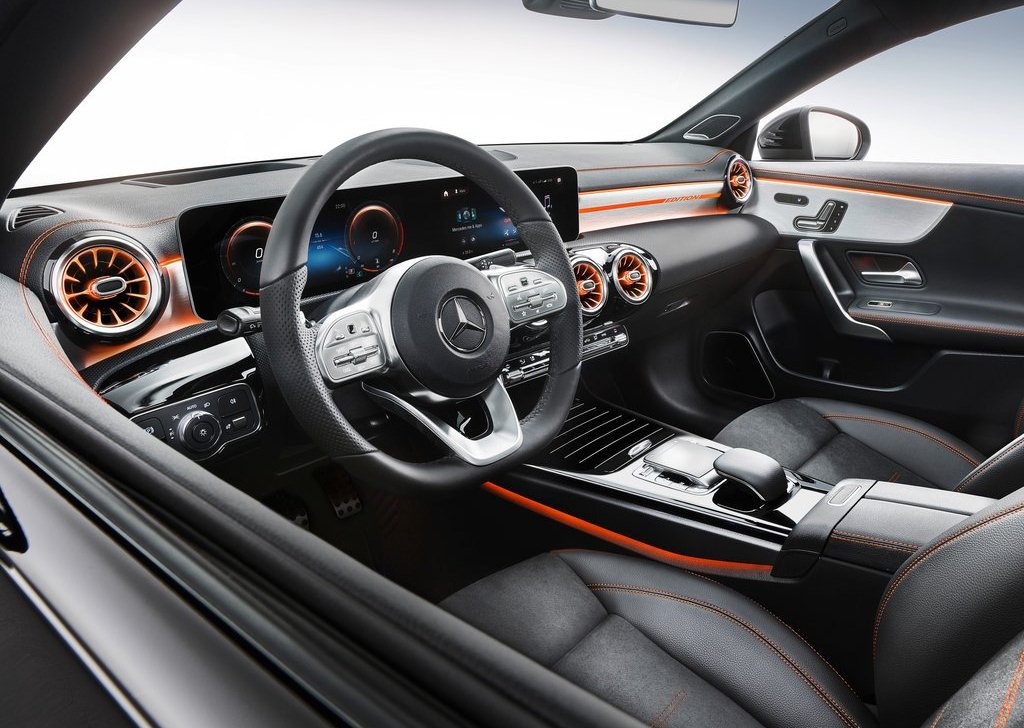The new Mercedes-Benz CLA Coupé is the most emotive vehicle in its class. The design underlines the coupé character with its stretched form and design elements such as the bonnet with powerdomes or the rear licence plate which has been moved down. As such it does justice to its predecessor's status as a design icon.
The combination of the long, stretched entry line above the windows and frameless doors give the Mercedes-Benz CLA Coupé its unmistakeable sporty and elegant character. Forming the front end is the striking front section which is raked forwards like a shark nose with a long, stretched bonnet featuring powerdomes.
The front: face of a classic sports car
Flat headlamps with the striking daytime running lamps together with the low slung bonnet and the diamond radiator grille with central star create the vehicle's sporty face, which has clear echoes of classic Mercedes-Benz sports cars. The two-piece, narrow tail lamps and the number plate housed in the bumper on the rear emphasise the width of the Mercedes-Benz CLA. The car thus appears flatter and sportier and has an especially good presence on the road.
The greenhouse set back and the sporty, gently sloping GT rear that culminates in a striking spoiler lip achieve a balance between elegance and sportiness, revealing the carefully elaborated aerodynamics. The reduced lines of the side profile allow plenty of space for precisely modelled surfaces. This creates an interesting play between light and shade, which lends the vehicle a strong presence. Dispensing with the upper shaped edge of the side wall permits muscular and athletic shoulder shaping, stretching from the front wheel arch through to the sculptured rear, and culminating just above the rear wheel arch. This creates a sense of tension, as if the car is ready to jump.
The M 282 petrol engine: four-cylinder with cylinder shutoff
The M 282 with a displacement of 1.33 litres forms the point of entry to the range of petrol engines in the CLA 180 and CLA 200. The engine excels with very compact dimensions, low weight (approx. 110 kg dry) and high static and dynamic rigidity. An electronically controlled wastegate and flexible charge pressure control ensure optimal charge pressure over the entire rpm and load range and thus efficiency and power when starting off.
For efficient partial-load operation, this engine initially in combination with the 7G-DCT transmission (CLA 180 6-speed manual available from June 2019) also has cylinder shutoff. Depending on the power requirement, in the range between 1250 and 3800 rpm the intake and exhaust valves of the second and third cylinder are closed by valve clearance adjustment. The remaining two cylinders therefore operate under higher loads, and therefore more efficiently. To minimise friction, the cylinder walls are coated using the patented NANOSLIDE® process and the piston skirts with a very hard-wearing Eco-Tough coating with graphite. The new compact four cylinder engine (10.6:1) comes with a particulate filter as standard and runs especially quietly thanks to extensive insulation and damping. The M 282 is produced in the Kölleda plant in Thuringia. It is combined with the six-speed manual transmission or the 7G DCT dual-clutch transmission.
The M 260 petrol engine: Trumpet-honing and variable valve timing system
In its engine block of die-cast aluminium, the two-litre M 260 engine from the more powerful CLA petrol variants has cast iron cylinder liners whereby the cylinder bore is widened at the lower end in line with the CONICSHAPE® principle, also known in-house as "trumpet-honing". This minimises piston friction and lowers fuel consumption along with new low-friction oil and optimised piston rings. The pistons themselves feature cooling ducts to take account of the higher specific output. The balance shafts for smooth engine-running are located in the lower section of the crankcase.
In the aluminium four-valve cylinder head, the CAMTRONIC variable valve timing system allows two-stage adjustment of the valve lift on the intake side. In the partial-load range with a smaller valve lift it reduces the load quantity and thus lowers gas cycle losses. In higher load ranges the system switches to the higher valve lift to achieve the engine's full power delivery. The direct injection uses the latest-generation piezo injection valves. Their installation position and control are meant to avoid raw emissions especially of particles. A particulate filter is also standard with the M 260.







![2026 Kia Sportage [EU] Review: A Refined European Crossover with Bold Style and Electrified Options](https://blogger.googleusercontent.com/img/b/R29vZ2xl/AVvXsEgqMRwJE1m90uCMgRSB6oc4bAzmAaKXJlNoCwavK5fXHaphLYY1sUVXdxUC94zuj95CdjDG2SqRnUBYMqta-dapTLIaHhzEdJAS821ldVMQOKfAZNpQlZ5fYTwKzKbKj8ad9QeKlaQPcNLRZ6zaGvuXhsg1kQ6zQCQqYtjmOM8q9u-a7Nl3WYjp773OLXJR/w680/2026%20Kia%20Sportage%20%5BEU%5D_01.jpg)








0 Comments